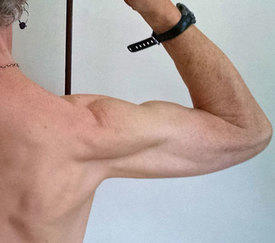Calculating my food intake

cdbuntin1972
Posts: 2 Member
How do I calculate the foods I ate when dining out at a restaurant
0
Replies
-
There are three basic options, any of which only gives you an estimate:
1. Look at a chain restaurant's web site to find a similar dish/meal. Use that as your estimate.
2. Look up the dish(es) in the MFP database, use those to estimate. If there are multiples, don't pick the lowest one (some are crazy-low). If there are lots of choices in the database, pick one in the commonest calorie range. If there are only a couple, pick one on the higher side.
3. "Deconstruct" the foods mentally, estimate the quantity of each ingredient, and log that. Pick a generous estimate for any oil, butter, cheese or cream likely to be in the dish, since restaurants often add large-ish amounts of those.
Yes, it's only an estimate. It isn't precise. If you eat at restaurants very, very frequently, you may want some additional strategies the old hands here can maybe help with, about how to pick calorie-efficient choices, or easy-to-estimate choices. If you only eat a hard-to-estimate restaurant meal once or twice a week, just make your best estimate, log it, and go on with life. It'll be fine.
(Credentials: I've been logging for 6+ years, just under a year losing from obese to healthy weight, 5+ years of maintenance. I do those kinds of estimates, and it works out OK in the long run.)4 -
I just try to look at similar entries in the database - get an idea of the calorie range and choose one that is in the middle or like 75% (higher than the mean, but lower than the highest calorie entry). It doesn't need to be exact exact if you are tracking correctly the rest of your time. Like, one day of being off a bit isn't going to ruin everything. Just be as accurate as you can as much of the time as you can --- it will never be perfect. And this is all estimation anyway.1
-
There are three basic options, any of which only gives you an estimate:
1. Look at a chain restaurant's web site to find a similar dish/meal. Use that as your estimate.
2. Look up the dish(es) in the MFP database, use those to estimate. If there are multiples, don't pick the lowest one (some are crazy-low). If there are lots of choices in the database, pick one in the commonest calorie range. If there are only a couple, pick one on the higher side.
3. "Deconstruct" the foods mentally, estimate the quantity of each ingredient, and log that. Pick a generous estimate for any oil, butter, cheese or cream likely to be in the dish, since restaurants often add large-ish amounts of those.
Yes, it's only an estimate. It isn't precise. If you eat at restaurants very, very frequently, you may want some additional strategies the old hands here can maybe help with, about how to pick calorie-efficient choices, or easy-to-estimate choices. If you only eat a hard-to-estimate restaurant meal once or twice a week, just make your best estimate, log it, and go on with life. It'll be fine.
(Credentials: I've been logging for 6+ years, just under a year losing from obese to healthy weight, 5+ years of maintenance. I do those kinds of estimates, and it works out OK in the long run.)
I deconstruct literally when practical, as I can get at least two meals from a US restaurant entrée. So when dining out I can bring half home and weigh it out, with, like you said, generous estimates for any oil, butter, cheese or cream.
I always found restaurants too noisy to be enjoyable, and have liked not having any pressure to eat out since early 2020.3 -
Thank you everyone for your insight.0
-
I deconstruct as best I can, and then always add a serving of oil to be safe, whether it tastes oily or not. I figure somehow, somewhere, there’s gotta be oil.
The only meal I’ve ever had trouble deconstructing was a lunch at a Brazilian home-style restaurant a couple weeks ago. First time I ever used “quick add”. It was a sort of buffet, so I got a tablespoon or two of each dish. I had absolutely no idea what some of it was, so I added 1,000 calories to my diary. It probably wasn’t even close to that high, but it was worth the gamble because everything was sooo good.
You can’t always sweat it. Do the best you can, and just remember, even if it’s not perfectly logged, “it’s better than it was before”.1 -
Restaurants are tricky. Anyone who has worked in a kitchen without a "no variations" manual knows that everything tastes better and get get more customer satisfaction when butter and oil is added. I have seen fried rice made for a side dish for 4 diners with a cup of sesame oil (2000 calories for the oil alone). And, it is awkward to ask probing questions about ingredients which the servers do not usually know about.
So, I stay with things I understand and can't be cheated on too much like whole fish broiled or baked, grilled meat, baked potato, etc.0
This discussion has been closed.
Categories
- All Categories
- 1.4M Health, Wellness and Goals
- 398.5K Introduce Yourself
- 44.7K Getting Started
- 261K Health and Weight Loss
- 176.4K Food and Nutrition
- 47.7K Recipes
- 233K Fitness and Exercise
- 462 Sleep, Mindfulness and Overall Wellness
- 6.5K Goal: Maintaining Weight
- 8.7K Goal: Gaining Weight and Body Building
- 153.5K Motivation and Support
- 8.4K Challenges
- 1.4K Debate Club
- 96.5K Chit-Chat
- 2.6K Fun and Games
- 4.8K MyFitnessPal Information
- 18 News and Announcements
- 21 MyFitnessPal Academy
- 1.5K Feature Suggestions and Ideas
- 3.2K MyFitnessPal Tech Support Questions




